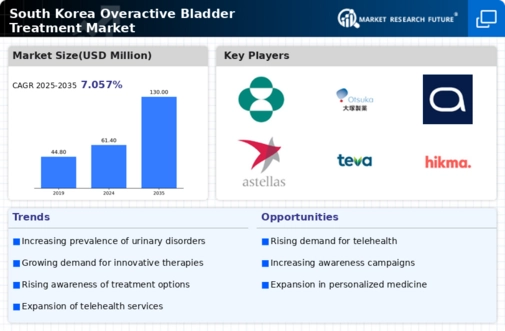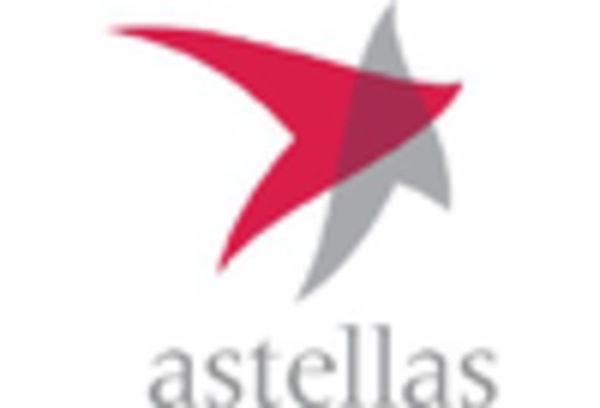Growing Healthcare Expenditure
The increasing healthcare expenditure in South Korea is a pivotal factor propelling the overactive bladder-treatment market. With the government allocating a substantial portion of its budget to healthcare services, there is a notable rise in funding for OAB treatments. In 2025, healthcare spending is expected to reach approximately 8.5% of the GDP, reflecting a commitment to improving patient care. This financial support facilitates access to advanced treatment options, including medications and surgical interventions, thereby enhancing patient outcomes. Additionally, the expansion of health insurance coverage for OAB treatments encourages more individuals to seek help, further stimulating market growth. As healthcare expenditure continues to rise, the overactive bladder-treatment market is poised to benefit from increased investment in innovative therapies and patient education initiatives.
Advancements in Pharmaceutical Solutions
Innovations in pharmaceutical treatments are significantly influencing the overactive bladder-treatment market. Recent developments in drug formulations and delivery mechanisms have led to the introduction of more effective medications with fewer side effects. For instance, the emergence of antimuscarinic agents and beta-3 adrenergic agonists has provided patients with diverse options tailored to their specific needs. The market is projected to grow as these advancements enhance patient compliance and satisfaction. Moreover, the South Korean healthcare system's emphasis on evidence-based medicine encourages the adoption of new therapies, further driving market expansion. As pharmaceutical companies invest in research and development, the overactive bladder-treatment market is likely to witness a surge in innovative products, catering to the evolving demands of healthcare providers and patients alike.
Increasing Prevalence of Overactive Bladder
The rising incidence of overactive bladder (OAB) in South Korea is a crucial driver for the overactive bladder-treatment market. Recent studies indicate that approximately 16% of the adult population experiences symptoms of OAB, which translates to millions of individuals seeking effective treatment options. This growing prevalence is likely to increase demand for various therapeutic interventions, including medications and lifestyle modifications. As awareness of OAB symptoms expands, more patients are likely to consult healthcare professionals, thereby propelling market growth. Furthermore, the aging population in South Korea, with a significant portion over 65 years, is particularly susceptible to OAB, further amplifying the market's potential. The overactive bladder-treatment market is thus positioned to benefit from this demographic shift, as healthcare providers focus on addressing the needs of this expanding patient base.
Enhanced Patient Education and Support Programs
The implementation of comprehensive patient education and support programs is emerging as a significant driver for the overactive bladder-treatment market. In South Korea, healthcare providers are increasingly focusing on educating patients about OAB symptoms, treatment options, and lifestyle modifications. These initiatives aim to empower patients to take an active role in managing their condition, which may lead to improved treatment adherence and outcomes. Furthermore, support groups and online resources are becoming more prevalent, providing patients with valuable information and community support. As awareness of OAB grows, the demand for effective treatment options is likely to increase, thereby benefiting the overactive bladder-treatment market. Enhanced patient education not only fosters better health outcomes but also encourages individuals to seek timely medical intervention, further driving market growth.
Rising Interest in Minimally Invasive Procedures
The growing preference for minimally invasive procedures is significantly impacting the overactive bladder-treatment market. Patients in South Korea are increasingly seeking alternatives to traditional surgical options, favoring treatments that offer quicker recovery times and reduced complications. Techniques such as sacral neuromodulation and Botox injections are gaining traction as effective solutions for managing OAB symptoms. This shift towards less invasive options is likely to attract a broader patient demographic, including those hesitant to undergo major surgeries. As healthcare providers adopt these innovative techniques, the overactive bladder-treatment market is expected to expand, catering to the evolving preferences of patients. The trend towards minimally invasive procedures not only enhances patient satisfaction but also aligns with the overall movement towards personalized and patient-centered care.

















Leave a Comment